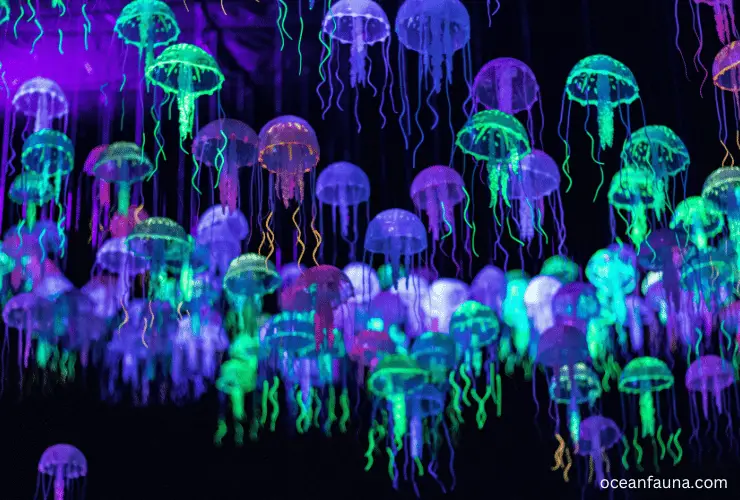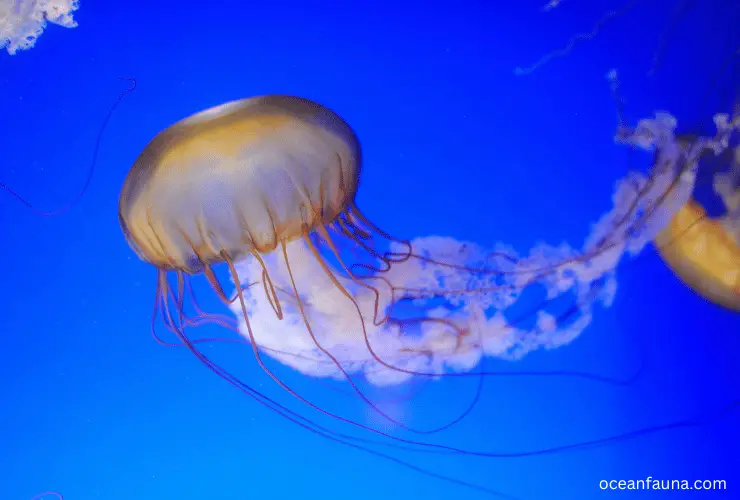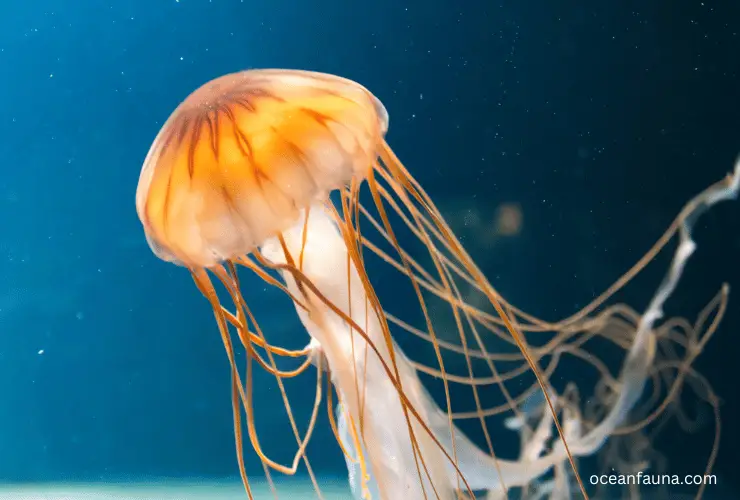Jellyfish don’t have blood or anything similar. The two major layers (epidermis and gastrodermis), and nerve nets perform transferring commands, oxygen, or energy. Almost every jellyfish specie have this same body function.
The layers of the jellyfish bell are so thin that they can absorb oxygen or release carbon dioxide through the tissues underwater. Along with that, they don’t have any major specified organs that require transferring oxygen or food energy to be transferred through any inner body fluid. That’s why jellyfish don’t require to have blood in their body.
Do Jellyfish Have Blood?
No, jellyfish don’t have blood in their bodies because they don’t need it. People often ask do they have blue blood. Answer is they don’t even have anything colored red or blue that acts like blood.
What is the basic function of blood in our body? Blood actually transfers oxygen in our body to perform respiration and spreads food energy in every single tissue of the body.

In the case of jellyfish, the respiration process solely depends on diffusion. Also, the two major thin layers can easily soak oxygen from the water to let the body perform diffusion. So, they don’t need blood to carry oxygen throughout the body.
Besides, the digestion of jellyfish is pretty simple that doesn’t require any specified organs. The most important note is that a jellyfish’s body doesn’t have complex organs like compound limbs, brains, kidneys, liver, etc. that need the food energy to be delivered efficiently.
That’s why after digestion, the bell accepts food values and keeps the whole body, including its tentacles, active. Here, the need for blood is also zero, unlike other creatures.
Why Do Jellyfish Not Have Blood?
Other organs do things that blood does in the body in a relatively simple way in the jellyfish anatomy. Along with that, there are some other major reasons why you won’t find blood in a jellyfish. Here are those:
- Jellyfish are mainly more like plankton. They’re not fishes. So naturally, they won’t have everything that vertebrates have.
- Jellyfish have also survived the pre-historic periods. Despite that, they’ve evolved very little.
- The breathing process of jellyfish is diffusion-based and performed by the epidermis layer. Each ectoderm tissue contains a small number of cells. For that reason, the oxygen can be easily soaked inside and delivered into the whole bell without blood.
- Jellyfish have only two to three specified organs. So, the central nerves don’t need the help of blood to circulate the food energy to the doorstep of every organ using blood.
- After snacking or breathing, the jellyfish body doesn’t need to dispose of the waste to purify any inner body part. The CO2 can easily be released through the epidermis and gastrodermis layers. And food waste easily gets rejected by the same opening for consuming food. While disposing of the waste, none of the organs get corrupted. Thus, any sort of purification with the help of blood is not needed.
Ultimately, there’s no need for blood to be present in the jellyfish body. That’s why even after living for millions of years on this planet, jellyfish haven’t grown hearts or blood in their body by evolution.
How Do Jellyfish Live Without Blood?

Jellyfish live without blood because the basic purpose of having blood in an animal body is missing in the jellyfish species. If you look closely, jellyfish have see-through bodies that show how straight and simple the anatomy is.
Because of not having major body parts, the existing body parts have adapted different roles to perform so that a jellyfish can survive well like any other sea creature without any flaw.
The multi-tasking organs or tissues help the jellyfish to live for years or mutate without having a brain, heart, lung, blood, reproductive organ, etc.
The central nervous system directly allows the whole body to live on instincts. Even so, they can survive pretty well, as they are mostly seen in a group or pact. Because of this, the chance of not being able to compete to live is pretty low.
What Do Jellyfish Have Instead of Blood?
Before knowing what the substitutes of blood in the jellyfish body are, let’s know what the primary tasks of jellyfish are. Here’s the list in short
- Oxygen and carbon dioxide transportation
- Nutrient transportation
- Temperature management
- The moisture level of cells and tissues.
Now, compare this stuff. A jellyfish’s body also requires those tasks to be performed to live well. But in this case, all those activities are done by other organs or parts instead of blood. To clearly understand the matter, see these facts:
- O2 and CO2 transportation isn’t required as anatomy is compact. O2 is soaked and spread into the body with the help of ectoderm tissues.
- After consuming food with the help of enzymes, the nutrient reaches every corner of the body through the gelatin-like middle layer and other tissues.
- As jellyfish are underwater creatures, the temperature doesn’t need to be regulated. The central nerve nets fix the movement and change in the body to face any critical environment.
- A jellyfish’s body consists of 95% water. So, the moisture level is never an issue for jellyfish.

As you can see, the tasks of blood in the first listing are either performed or neglected by several existing organs of jellyfish to have a perfect balance. In short, a jellyfish can never feel the absence of blood due to the adaptation of other organs to stay alive.
FAQs
What is the color of jellyfish blood?
There is no jellyfish specie that has blood in the body. And anything in the body working instead of blood also have no specific color. So, jellyfish blood has no color.
Do Jellyfish Bleed?
No, a jellyfish’s body contains only water and jellies. If you cut the bell, you’d see the body is ejecting either water or gelatin.
Do Jellyfish Have Heart?
As the jellyfish don’t have any blood, they also don’t have hearts. The primary objective of a heart is to pump blood. That’s why there’s no heart in the jellyfish body because blood is absent.
How Can Jellyfish Get Energy from Food Without Having Blood?
Jellyfish have layers of tissues that aren’t completely thick. When they consume any food and break them with the help of enzymes, the nutrients get passed through every cell in the body without any help of blood-like fluids.
Conclusion
The main thing you need to remember is jellyfishes are only fishes by name. They have far under-developed anatomy than any other sea vertebrates. Thus, living without blood in the body is nothing astonishing in the case of jellyfish.
Jellyfish have evolved to keep a compact body structure so that they can move freely by squeezing or extending their bodies under the sea. Having any organ that’s completely not required might block their natural movement or living. As the duties of blood are easily done by other tissues and cells in the jellyfish body, there’s no need for jellyfish to have blood or a heart.

